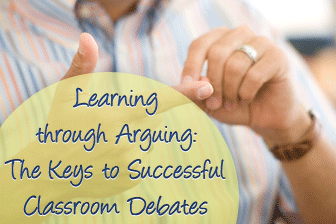
Regardless of student background or proficiency level, nearly all students love a good fight—with words that is.
Nothing gets students more motivated to speak English than by having the opportunity to debate with their peers. Holding a classroom debate is a magnificent way for students to practice spontaneous speech; however, in many classes debates fall flat. Below are a few tips to make sure that your next debate will effectively engage all students in the class and enhance their language skills.

HOWTO: Successful Classroom Debates
-
1
Student-selected Topics
Debates will be much more successful and interesting for everyone involved if the participants are interested and passionate about their controversial topic. As a whole class, brainstorm potential debate topics that are suitable for the class, and try to narrow it down to a list of six or seven topics.
Have students rank their top five preferences and indicate their position (Pro or Con). Collect the students’ preferences, and try to match students according to their top five choices. More often than not, it will work out to give each student one of their top picks and still have enough students on each side.
-
2
Less is More
One of the biggest flaws in formal debates with an entire class is that the dominant personalities take center stage and monopolize the speaking time. Having shorter debates with fewer participants (ideally four: two Pro and two Con) allows all students to get more speaking time.
-
3
Build the Anticipation
You should introduce the debate topic with enough time in advance to motivate your students to be excited about the debate. Play some games in the classes leading up to the debate, and allow the competing teams to play against each other to build rivalry.
Give students a few days to work together to conduct research and an outline. Ensure that students meet together as groups and are organized when it is their turn to debate (who’s speaking first, second, third, etc…).
-
4
Equip Them with Essential Vocabulary
Debates are great ways to get students to include useful pragmatic language for disagreeing with others, expressing their opinions, and negotiate turn-taking roles for who gets to speak next. Useful transition words to teach include: In my opinion… I understand; however… With all due respect... May I interrupt? and Please let me finish. These phrases should be taught and practiced in class activities before the debate, such as in role plays.
-
5
Have Structure, but Not Too Much Structure
Introduce the format of the debate to students in advance so they can be organized. This can be modified based on your classroom dynamics, but a simple format that works well goes like this : 1) Pro Team introduction and reasons; 2) Con Team introduction and reasons; 3) open debate; 4) audience questions; 5) Pro Team conclusion; 6) Con Team conclusion.
Typically, the purpose of debates is to encourage spontaneous, reasoned speech. Too much structure encourages students to read from a script; but too little structure could result in a screaming match. During the open debate time, have a ball or an object that can be passed from speaker to speaker, and only the person holding the object may speak at that time.
-
6
Getting Everyone Involved
While two teams are debating, what do you do with the remaining students in the audience? To keep these students active and engaged, involve them in the evaluation process. Create a rubric ahead of time that students can fill out as they listen to the debate. Have the audience rate the speakers, critique their ideas, and decide on the winner. Asking each student to write down one question based on the debater’s comments will also help to keep them feeling included in this class exercise.
-
7
Mum’s the Word
As a teacher, your facilitator role should be minimal. If you have set up the debate format properly, the students should be able to monitor one another and carry out the debate. This allows students to practice how to handle interruptions and turn taking negotiations. Only intervene when absolutely necessary; the more autonomous the students can be, the more they will learn from this exercise.
When done properly, debates foster a great classroom environment by encouraging teamwork and friendly competition.
Debates help reach multiple classroom objectives: they not only practice speaking and listening skills, but also motivate students, develop their argumentation strategies, and encourage learner autonomy. After the arguing is finished, everyone has improved their English!
P.S. If you enjoyed this article, please help spread it by clicking one of those sharing buttons below. And if you are interested in more, you should follow our Facebook page where we share more about creative, non-boring ways to teach English.







